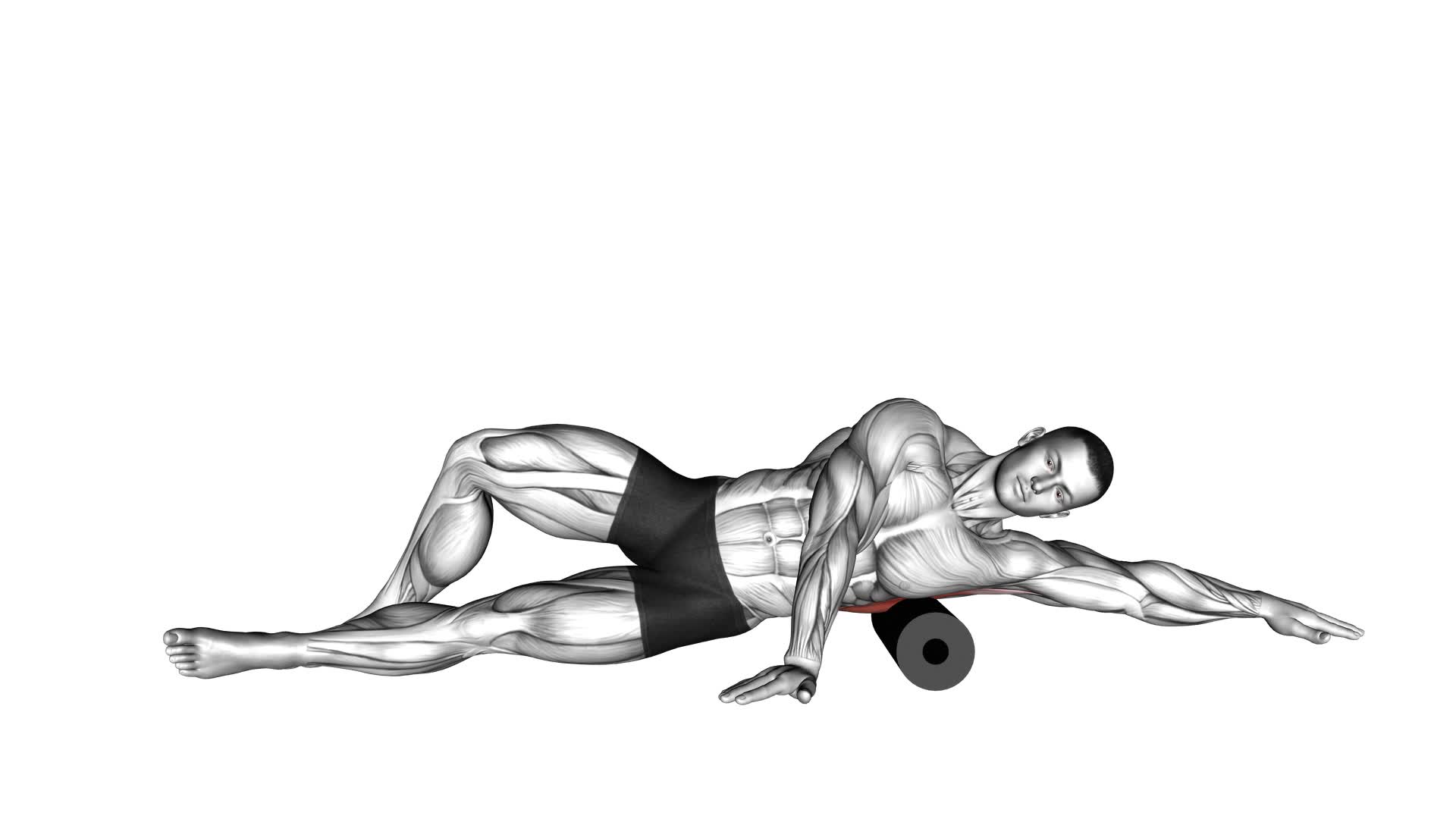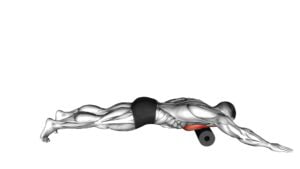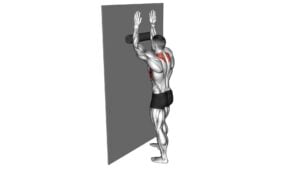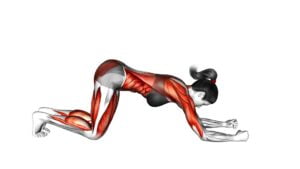Roll Lat Foam Rolling – Video Exercise Guide & Tips

Are you looking for a quick and effective way to loosen up your lats? Look no further!
Watch This Exercise Video
In this article, we'll show you how to roll your lat muscles using a foam roller. With our video exercise guide and expert tips, you'll learn the proper technique and avoid common mistakes.
Plus, we'll share advanced exercises and tips for incorporating foam rolling into your fitness routine.
Get ready to maximize your results with foam rolling!
Key Takeaways
- Foam rolling the lats can increase flexibility and improve muscle recovery.
- Foam rolling the lats can help alleviate back pain by targeting the latissimus dorsi muscles.
- Foam rolling the lats can improve shoulder mobility by releasing tension in the muscles.
- Incorporating foam rolling into your fitness routine regularly can promote overall musculoskeletal health.
Benefits of Foam Rolling for Lats
Foam rolling your lats can provide numerous benefits for your overall flexibility and muscle recovery. When it comes to foam rolling for back pain, targeting the latissimus dorsi muscles can be incredibly effective. These muscles, located on the sides of your back, can often become tight and cause discomfort. By using a foam roller to apply pressure and massage these muscles, you can help alleviate tension and reduce back pain.
In addition to addressing back pain, foam rolling your lats can also improve shoulder mobility. The latissimus dorsi muscles play a crucial role in shoulder movement, as they connect the upper arm to the spine. When these muscles are tight or restricted, it can limit your range of motion in the shoulders. Foam rolling can help release tension in the lats, allowing for greater mobility and flexibility in the shoulders.
By incorporating foam rolling for your lats into your regular routine, you can experience the benefits of increased flexibility and reduced muscle soreness. It's important to note that consistency is key when it comes to foam rolling. Regularly incorporating this practice into your fitness regimen can help prevent muscle imbalances and promote overall musculoskeletal health.
Proper Technique for Foam Rolling Lats
When targeting your lats with foam rolling, it's important to use proper technique to effectively release tension and promote muscle recovery.
Foam rolling is a great way to stretch and massage your lats, helping to alleviate any tightness and discomfort.
To properly foam roll your lats, start by lying on your side with the foam roller positioned underneath your armpit.
Place your top arm on the ground to support your body weight, and use your legs to control the pressure on the foam roller.
Slowly roll back and forth, from your armpit to your mid-back, focusing on any areas of tightness or discomfort.
Make sure to maintain a steady and controlled movement throughout the exercise.
Additionally, you can vary the pressure by adjusting the angle of your body and the amount of weight you place on the foam roller.
Common Mistakes to Avoid
When it comes to foam rolling your lats, it's important to avoid common mistakes that can lead to injury and reduce the effectiveness of your workout.
One common mistake is using improper form, which can put unnecessary strain on your muscles and joints.
Another mistake to avoid is skipping a proper warm-up, as this can limit the benefits of foam rolling.
Lastly, using the wrong type of foam roller can also hinder your progress, so make sure to choose one that's suited for your specific needs.
Improper Form Risks Injury
Using improper form during foam rolling exercises can put you at risk for injury. To ensure injury prevention and get the most out of your foam rolling sessions, it's important to pay attention to your technique. Here are some common mistakes to avoid:
- Applying too much pressure: Pressing too hard on the foam roller can lead to excessive discomfort and potential muscle damage. Remember to start with light pressure and gradually increase as needed.
- Rolling too fast: Rapid movements can reduce the effectiveness of foam rolling and increase the risk of injury. Slowly roll over the targeted muscle area, taking time to release any tension.
- Holding your breath: Holding your breath can increase muscle tension and restrict blood flow. Remember to breathe deeply and relax as you roll.
By avoiding these mistakes and practicing proper foam rolling techniques, you can minimize the risk of injury and maximize the benefits of your exercise routine.
Now let's discuss how skipping warm-up reduces effectiveness.
Skipping Warm-Up Reduces Effectiveness
To maximize the benefits of your foam rolling routine and avoid injury, it's crucial to address the common mistake of skipping the warm-up, as it reduces the effectiveness of your exercises. By reducing warm-up time or skipping stretching altogether, you aren't properly preparing your muscles for the foam rolling session. Warm-ups increase blood flow, loosen up the muscles, and enhance flexibility, making the foam rolling exercises more effective. Without a proper warm-up, you risk not fully activating the muscles and not achieving the desired results. Additionally, skipping the warm-up increases the chances of injury. So, take the time to warm up before your foam rolling routine to reap the full benefits and minimize the risk of injury.
Now, let's move on to the next common mistake: using an incorrect foam roller.
Using Incorrect Foam Roller
To ensure optimal results and prevent potential injuries, it's important to avoid using an incorrect foam roller in your routine. Using the wrong foam roller or employing incorrect technique can hinder the effectiveness of your foam rolling session. Here are some common mistakes to avoid:
- Choosing a foam roller that's too soft or too firm for your needs. The density of the foam roller should match your level of experience and the specific muscle group you're targeting.
- Neglecting to check the size of the foam roller. Using a roller that's too small for the muscle group you're working on may not provide adequate pressure or coverage.
Advanced Foam Rolling Exercises for Lats
For more intense foam rolling exercises that target your lats, try incorporating advanced techniques. These advanced foam rolling techniques can provide even greater benefits for your lats, helping to improve flexibility, reduce muscle tension, and enhance overall performance.
One effective advanced technique is the side-lying lat roll. To perform this exercise, lie on your side with the foam roller placed under your armpit. Using your legs and arms to control the movement, roll along the length of your lat muscles, from your armpit to your ribcage.
Another advanced technique is the lat stretch and roll. Start by stretching your lat muscles by extending one arm overhead and leaning to the opposite side. Then, position the foam roller under your extended arm and roll along the length of your lat muscles, applying pressure as needed.
Remember to breathe deeply and relax as you perform these advanced foam rolling exercises. Incorporating these techniques into your foam rolling routine can help you achieve maximum benefits for your lats.
Incorporating Foam Rolling Into Your Fitness Routine
To incorporate foam rolling into your fitness routine, you should be aware of the benefits it offers.
Foam rolling can help improve flexibility, increase blood flow, and reduce muscle soreness.
It's important to learn the best foam rolling techniques to effectively target different muscle groups and achieve optimal results.
Benefits of Foam Rolling
Incorporating foam rolling into your fitness routine can provide you with numerous benefits. Here are two key advantages of using a foam roller:
- Improving Flexibility: Foam rolling helps to release tight muscles and increase range of motion, leading to improved flexibility. By applying pressure to specific areas of the body, you can break up muscle knots and adhesions, allowing the muscles to lengthen and move more freely.
- Reducing Muscle Soreness: Foam rolling can help alleviate muscle soreness and aid in recovery after intense workouts. By rolling over the muscles, you increase blood flow to the area, which helps flush out metabolic waste products and deliver oxygen and nutrients to the muscles, promoting faster healing and reducing soreness.
Incorporating foam rolling into your fitness routine can be a valuable tool for improving flexibility and reducing muscle soreness, allowing you to perform at your best.
Best Foam Rolling Techniques
Get the most out of your fitness routine by incorporating foam rolling techniques into your workouts. Foam rolling offers numerous benefits, such as improved flexibility, increased blood flow, and reduced muscle soreness. To maximize these benefits, here are some effective foam rolling exercises to try:
- Quadriceps Roll: Start by lying face down with the foam roller placed under your thighs. Roll from your hips to just above your knees, focusing on any tight or sore spots.
- IT Band Roll: Lie on your side with the foam roller positioned under your hip. Roll along the outside of your thigh, from your hip to just above your knee. This is particularly beneficial for runners and cyclists.
- Upper Back Roll: Sit on the floor with the foam roller placed behind you. Roll from your upper back to your mid-back, applying gentle pressure to release tension.
Remember to breathe deeply and maintain proper form while foam rolling. Incorporating these techniques into your fitness routine can enhance your overall performance and recovery.
Tips for Maximizing Results With Foam Rolling
For optimal results with foam rolling, make sure to dedicate enough time to the practice. Foam rolling is a great tool for maximizing muscle recovery and improving overall performance. Here are some tips to help you get the most out of your foam rolling sessions:
- Start with a warm-up: Before you begin foam rolling, it's important to warm up your muscles. This can be done through light cardio exercises or dynamic stretches.
- Target specific muscle groups: Foam rolling is most effective when you focus on specific areas of your body that need attention. Identify the muscles that are tight or sore and spend extra time rolling them out.
- Apply the right amount of pressure: When foam rolling, it's important to find a balance between too much and too little pressure. Apply enough pressure to feel a slight discomfort, but not so much that it becomes painful.
- Roll slowly and deliberately: To maximize the benefits of foam rolling, roll slowly and deliberately over each muscle group. Take your time and apply consistent pressure throughout the movement.
- Breathe and relax: It's important to relax your muscles and breathe deeply while foam rolling. This will help release tension and improve the effectiveness of the practice.
Frequently Asked Questions
Can Foam Rolling Help With Shoulder Pain or Tightness?
Foam rolling can be an effective technique for relieving shoulder pain or tightness. By targeting the muscles in your shoulders, foam rolling can help to release tension and increase flexibility.
Regular foam rolling can also improve blood circulation, which promotes healing and reduces inflammation.
When using foam rolling techniques for shoulder pain relief, make sure to apply enough pressure to target the specific areas of discomfort.
Remember to consult with a healthcare professional for personalized advice and guidance.
How Often Should I Foam Roll My Lats?
To get the most out of foam rolling your lats, it's important to consider the frequency. Foam rolling your lats a few times a week can help relieve muscle tension and improve flexibility.
Regular foam rolling can also enhance your overall performance and prevent muscle imbalances. By incorporating foam rolling into your routine, you can experience the benefits of increased range of motion and decreased muscle soreness.
Are There Any Precautions or Contraindications for Foam Rolling the Lats?
When foam rolling your lats, it's important to be aware of any precautions or contraindications. While foam rolling can have many benefits, it's not suitable for everyone.
If you have any injuries or pain in your shoulder, neck, or upper back, it's best to consult with a healthcare professional before attempting this exercise. They can provide guidance on whether foam rolling your lats is safe for you and offer alternative exercises if needed.
Can Foam Rolling the Lats Improve Posture?
Foam rolling the lats can improve your posture by helping to increase flexibility and reduce muscle soreness. By targeting the lats, foam rolling can release tension and tightness in these muscles, allowing for better alignment and posture.
It can also help to improve overall mobility and range of motion in the upper body. Incorporating foam rolling into your routine can be an effective way to address postural issues and promote better posture.
Is Foam Rolling the Lats Beneficial for Athletes Who Perform Overhead Movements, Such as Weightlifting or Swimming?
Foam rolling the lats can be highly beneficial for athletes who perform overhead movements like weightlifting or swimming. It helps improve flexibility, mobility, and range of motion in the shoulders and upper back.
By using foam rolling techniques specifically targeting the lats, you can release tension and tightness in these muscles, allowing for better performance and reducing the risk of injury.
Incorporating foam rolling into your routine can enhance your overall athletic abilities.
Conclusion
Foam rolling is a beneficial technique for improving the flexibility and mobility of the lat muscles. By using proper technique and avoiding common mistakes, you can effectively target and release tension in your lats.
Advanced foam rolling exercises can further enhance your results. Incorporating foam rolling into your fitness routine and following these tips will help you maximize the benefits and improve your overall performance.
So grab a foam roller and start rolling your way to stronger, more flexible lats!

Author
Years ago, the spark of my life’s passion ignited in my mind the moment I stepped into the local gym for the first time. The inaugural bead of perspiration, the initial endeavor, the very first surge of endorphins, and a sense of pride that washed over me post-workout marked the beginning of my deep-seated interest in strength sports, fitness, and sports nutrition. This very curiosity blossomed rapidly into a profound fascination, propelling me to earn a Master’s degree in Physical Education from the Academy of Physical Education in Krakow, followed by a Sports Manager diploma from the Jagiellonian University. My journey of growth led me to gain more specialized qualifications, such as being a certified personal trainer with a focus on sports dietetics, a lifeguard, and an instructor for wellness and corrective gymnastics. Theoretical knowledge paired seamlessly with practical experience, reinforcing my belief that the transformation of individuals under my guidance was also a reflection of my personal growth. This belief holds true even today. Each day, I strive to push the boundaries and explore new realms. These realms gently elevate me to greater heights. The unique combination of passion for my field and the continuous quest for growth fuels my drive to break new ground.







